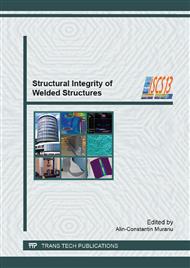p.115
p.123
p.127
p.135
p.141
p.147
p.159
p.165
p.173
Quality Requirements for the Design, Fabrication and Repair of Welded Vessels
Abstract:
The Eurocode standards provide common structural design rules. The design is based on selecting minimum weight members to satisfy given conditions. The standard applicable to the design of various tanks, vessels, containers and bottles for gas and liquid is: EN 1993-4-2; Eurocode 3; Design of steel structures; Part 4.2: Tanks. For the verification of certain mechanical characteristics of such vessels, the applied standard is EN 1993-1-6; Supplementary rules for the strength and stability of shell structures. Verification of the specific actions on structures, that imply dead and live loads, must be also applied for the tanks and vessels, according to EN 1991 and related standards. Construction of welded vessels must be performed with qualified welding procedures. WPS/PQR and welder approvals (EN 287 and EN ISO 15614) are required. The longitudinal and circumferential joints must be butt-welded, both with full penetration. Tolerances, heat treatment and marking are indicated. Some examples of own realized welded vessels are presented. Manufacturing inspection, by visual examination, must cover most aspects: bending, groove preparation, alignment before and after welding, welding process, penetration, tolerances for circumference, straightness and circularity, double-sided welds, heat treatment, small diameter welds around the nozzles, detecting of undercut, excessive convexity, distortions, etc. Defect acceptance criteria are presented, depending on the weld types and quality level, according to EN ISO 5817. Macrographic examination according to EN 1321 of a transverse section of the welds, tensile test according to EN ISO 4136 and radiography testing of welds in accordance with EN 1435 class B are required. For pressure vessels, according to the ISCIR Technical Prescriptions, active in Romania, C 4-2010 „Static metal pressure vessels”, respective C12-2010 „Technical requirements for metal tank, container and barrel recipients for compressed, liquefied and solved gases, under pressure”, tightness and hydrostatic tests are performed at the maximal design pressure for 60 min. For the stability verification, the ultimate limit state of local shell buckling should be applied, according to EN 1993-1-6, by the conventional method, stress design concept or global second order beam theory. The fatigue strength of the structural shell must be verified by the methods given in EN 1993-1-6. Weld repairs are allowed, with no limit on the number and extent of defects. The repairs by welding are carried out according to ASME Code, Sections IX and VIII. According to the ISCIR Technical Prescriptions, a technology for repair welding must be elaborated by the manufacturer and approved by ISCIR. The design, fabrication and repairs of vessels must be performed according to the mentioned standards, depending on the class of the vessel.
Info:
Periodical:
Pages:
141-146
Citation:
Online since:
September 2013
Authors:
Keywords:
Price:
Сopyright:
© 2013 Trans Tech Publications Ltd. All Rights Reserved
Share:
Citation:


